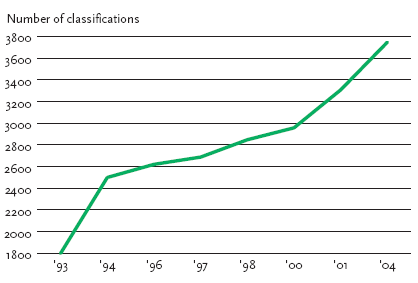|
| Front page | | Contents | | Previous | | Next |
Key indicators 2004
7
Number of chemicals which have been classified
Source: The National Environmental Research Institute, Denmark

The figure illustrates developments in common EU classifications of substances and substance groups. Classification is an integral part of the overall work undertaken to assess and regulate chemical
substances. Common EU classification creates a basis for common risk management, including bans on the sale of substances and products which are carcinogenic, mutagenic, or hazardous to embryos. The
figure does not include substances which have been self-classified by manufacturers.
Classifications increase in steps
The figure shows that the number of classified substances and related substances has more than doubled since 1993. The substances and substance groups classified at the end of 2004 comprise 8,000
substances of the total of 100,000 substances available on the European market, either now or
in the past. The number of completed classifications is subject to sudden increases, as a large number of classifications are completed at the same time. In 2004, a total of 450 substances were classified. A
new, updated Danish list of these substances will be published in spring 2005. The work is still in progress.
The increased number of common EU classifications underpins the objective that the use of hazardous chemicals must be limited and even banned, if there are harmful effects on human and animal health or
on nature. However, there is still a long way to go with the many thousands of chemicals we use every day.
| Front page | | Contents | | Previous | | Next | | Top |
Version 1.0 May 2005, © Danish Environmental Protection Agency
|